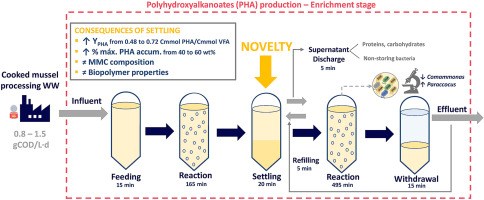当前位置:
X-MOL 学术
›
Chemosphere
›
论文详情
Our official English website, www.x-mol.net, welcomes your feedback! (Note: you will need to create a separate account there.)
Optimization of an enriched mixed culture to increase PHA accumulation using industrial saline complex wastewater as a substrate.
Chemosphere ( IF 8.8 ) Pub Date : 2020-01-11 , DOI: 10.1016/j.chemosphere.2020.125873 Lucía Argiz 1 , Andrea Fra-Vázquez 1 , Ángeles Val Del Río 1 , Anuska Mosquera-Corral 1
Chemosphere ( IF 8.8 ) Pub Date : 2020-01-11 , DOI: 10.1016/j.chemosphere.2020.125873 Lucía Argiz 1 , Andrea Fra-Vázquez 1 , Ángeles Val Del Río 1 , Anuska Mosquera-Corral 1
Affiliation

|
Polyhydroxyalkanoates (PHA) appear as good candidates to substitute conventional petroleum-based plastics since they have similar properties but with the advantage of being biodegradable. Wastewater streams with high organic content are feasible substrates for PHA production resulting in an opportunity for waste recovery. One of the main challenges is the optimization of the selection of microorganisms with high PHA storage capacity. This microbial selection is performed in sequencing batch reactors (SBR) operated under an aerobic feast/famine (F/F) regime. In the present study, a settling stage was added at the end of the feast phase of the enrichment cycle of a SBR fed with pre-acidified cooked mussel processing wastewater (containing up to 12 g NaCl/L). Settling and subsequent supernatant discharge favoured the wash-out of non-accumulating microorganisms as well as the removal of substances that enhanced their undesired development (proteins and carbohydrates). Microbial analysis performed by fluorescence in situ hybridization (FISH) technique showed shifts in the microbial community; the presence of genus Paracoccus increased whereas genera Comamonas decreased. Moreover, the process efficiency was improved with the increase of the PHA production yield (YPHA) and the maximum PHA storage capacity (max. PHA) from 0.48 to 0.72 CmmolPHA/CmmolVFA and from 40 to 60 wt%, respectively. The polymer composition also changed, its HB:HV ratio varied from 83:17 to 70:30. Results obtained in the present study showed that settling after the feast phase promoted the removal of carbon sources that did not contribute to PHA production and the washout of non-storing bacteria, which favoured the culture enrichment.
中文翻译:

使用工业盐类复杂废水作为底物,优化富集混合培养以增加PHA积累。
聚羟基链烷酸酯(PHA)似乎是替代常规石油基塑料的良好候选者,因为它们具有相似的性能,但具有可生物降解的优点。有机物含量高的废水流是生产PHA的可行底物,因此有回收废物的机会。主要挑战之一是优化具有高PHA储存能力的微生物的选择。这种微生物的选择是在有氧盛宴/饥荒(F / F)方案下运行的分批反应器(SBR)中进行的。在本研究中,在SBR的浓缩循环的盛宴阶段的末尾添加了沉降阶段,该阶段加入了预酸化的贻贝加工废水(含有高达12 g NaCl / L)。沉淀和随后的上清液排出有利于洗去非蓄积性微生物,以及去除会增强其不良发育的物质(蛋白质和碳水化合物)。通过荧光原位杂交(FISH)技术进行的微生物分析表明,微生物群落发生了变化。副球菌属的存在增加而Comamonas属的减少。此外,随着PHA产量(YPHA)和最大PHA储存容量(最大PHA)分别从0.48至0.72 CmmolPHA / CmmolVFA和40至60 wt%的增加,工艺效率得到了改善。聚合物组成也发生变化,其HB:HV比从83:17到70:30不等。
更新日期:2020-01-13
中文翻译:

使用工业盐类复杂废水作为底物,优化富集混合培养以增加PHA积累。
聚羟基链烷酸酯(PHA)似乎是替代常规石油基塑料的良好候选者,因为它们具有相似的性能,但具有可生物降解的优点。有机物含量高的废水流是生产PHA的可行底物,因此有回收废物的机会。主要挑战之一是优化具有高PHA储存能力的微生物的选择。这种微生物的选择是在有氧盛宴/饥荒(F / F)方案下运行的分批反应器(SBR)中进行的。在本研究中,在SBR的浓缩循环的盛宴阶段的末尾添加了沉降阶段,该阶段加入了预酸化的贻贝加工废水(含有高达12 g NaCl / L)。沉淀和随后的上清液排出有利于洗去非蓄积性微生物,以及去除会增强其不良发育的物质(蛋白质和碳水化合物)。通过荧光原位杂交(FISH)技术进行的微生物分析表明,微生物群落发生了变化。副球菌属的存在增加而Comamonas属的减少。此外,随着PHA产量(YPHA)和最大PHA储存容量(最大PHA)分别从0.48至0.72 CmmolPHA / CmmolVFA和40至60 wt%的增加,工艺效率得到了改善。聚合物组成也发生变化,其HB:HV比从83:17到70:30不等。


























 京公网安备 11010802027423号
京公网安备 11010802027423号